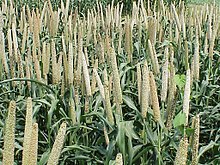
Back Pêrelbalalagras Afrikaans ثيوم أغبر Arabic ثيوم اغبر ARZ Afrika darısı Azerbaijani Мяшэй шызы Byelorussian बजड़ी Bihari Mill perlat Catalan Cenchrus americanus CEB Perlhirse German ބާދިރީ DV
This article needs additional citations for verification. (June 2021) |
| Pearl millet | |
|---|---|

| |
| Pearl millet hybrid for grain | |
| Scientific classification | |
| Kingdom: | Plantae |
| Clade: | Tracheophytes |
| Clade: | Angiosperms |
| Clade: | Monocots |
| Clade: | Commelinids |
| Order: | Poales |
| Family: | Poaceae |
| Subfamily: | Panicoideae |
| Genus: | Cenchrus |
| Species: | C. americanus
|
| Binomial name | |
| Cenchrus americanus (L.) Morrone
| |
| Synonyms[1] | |
|
List
| |
Pearl millet (Cenchrus americanus, commonly known as the synonym Pennisetum glaucum) is the most widely grown type of millet. It has been grown in Africa and the Indian subcontinent since prehistoric times. The center of diversity, and suggested area of domestication, for the crop is in the Sahel zone of West Africa.[2] Recent archaeobotanical research has confirmed the presence of domesticated pearl millet on the Sahel zone of northern Mali between 2500 and 2000 BC.[3][4] 2023 was the International Year of Millets, declared by the United Nations General Assembly in 2021.[5]
- ^ "Cenchrus americanus (L.) Morrone". Plants of the World Online. Royal Botanic Gardens, Kew. Retrieved 15 November 2020.
- ^ Winchell, Frank; Brass, Michael; Manzo, Andrea; Beldados, Alemseged; Perna, Valentina; Murphy, Charlene; Stevens, Chris; Fuller, Dorian Q. (2018-12-01). "On the Origins and Dissemination of Domesticated Sorghum and Pearl Millet across Africa and into India: a View from the Butana Group of the Far Eastern Sahel". African Archaeological Review. 35 (4): 483–505. doi:10.1007/s10437-018-9314-2. ISSN 1572-9842. PMC 6394749. PMID 30880862.
- ^ Manning K, Pelling R, Higham T, et al. (2011). "4500-year-old domesticated pearl millet (Pennisetum glaucum) from the Tilemsi Valley, Mali: new insights into an alternative cereal domestication pathway". Journal of Archaeological Science. 38 (2): 312–322. Bibcode:2011JArSc..38..312M. doi:10.1016/j.jas.2010.09.007. ISSN 0305-4403.
- ^ Fuller, D.Q. (2003). "African crops in prehistoric South Asia: a critical review". In Neumann K, Butler A, Kahlheber S (eds.). Food, Fuel and Fields: Progress in Africa Archaeobotany. Africa Praehistorica. Vol. 15. Cologne: Heinrich-Barth-Institut. pp. 239–271. ISBN 3-927688-20-7.
- ^ "International Year of Millets 2023". United Nations Food and Agriculture Organization. 2022.
© MMXXIII Rich X Search. We shall prevail. All rights reserved. Rich X Search